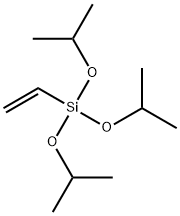Trichlorovinylsilane
Synonym(s):(Trichlorosilyl)ethylene;Vinyltrichlorosilane
- CAS NO.:75-94-5
- Empirical Formula: C2H3Cl3Si
- Molecular Weight: 161.49
- MDL number: MFCD00000482
- EINECS: 200-917-8
- SAFETY DATA SHEET (SDS)
- Update Date: 2025-01-27 09:38:02

What is Trichlorovinylsilane?
Chemical properties
Colorless or pale-yellow liquid. Readily hydrolyzed with liberation of hydrogen chloride; polymerizes easily; soluble in most organic solvents; reacts with alcohol.
The Uses of Trichlorovinylsilane
A study reports the possible use of this silane for treating Pluronic F127, chitosan for better attachment and proliferation of endothelial cells on biomaterials. Trichlorovinylsilane may be used to prepare epoxy terminated carbosiloxane.
General Description
Vinyltrichlorosilane appears as a colorless to pale yellow fuming liquid with a pungent odor. Vapor and liquid may cause burns. More dense than water. Vapors are heavier than air.
Reactivity Profile
Chlorosilanes, such as Trichlorovinylsilane, are compounds in which silicon is bonded to from one to four chlorine atoms with other bonds to hydrogen and/or alkyl groups. Chlorosilanes react with water, moist air, or steam to produce heat and toxic, corrosive fumes of hydrogen chloride. They may also produce flammable gaseous H2. They can serve as chlorination agents. Chlorosilanes react vigorously with both organic and inorganic acids and with bases to generate toxic or flammable gases.
Health Hazard
Inhalation causes irritation of mucous membranes. Vapor irritates eyes. Contact with liquid causes severe burns of eyes and skin. Ingestion causes burns of mouth and stomach.
Safety Profile
Moderately toxic by ingestion, inhalation, and sktn contact. A corrosive irritant to skin, eyes, and mucous membranes. A very dangerous fire hazard when exposed to heat or flame. Reacts violently with water, moist air, or steam to produce toxic and corrosive fumes. When heated to decomposition it emits toxic fumes of Cl-. See also CHLOROSILANES.
Purification Methods
Fractionally distil it at atmospheric pressure. It is water sensitive and is stored in the dark and it is likely to polymerise. [Müller & Schnurrbusch Chem Ber 91 1805 1958, Munkelt & Müller Chem Ber 92 1012 1959, Polarography: Abrahamson & Reynolds Anal Chem 24 1827 1952, Beilstein 4 IV 4258.]
Properties of Trichlorovinylsilane
| Melting point: | −95 °C(lit.) |
| Boiling point: | 90 °C(lit.) |
| Density | 1.27 g/mL at 25 °C(lit.) |
| vapor density | >1 (vs air) |
| vapor pressure | 60 mm Hg ( 23 °C) |
| refractive index | n |
| Flash point: | 51 °F |
| storage temp. | 0-6°C |
| form | liquid |
| color | colorless |
| Specific Gravity | 1.27 |
| Water Solubility | reacts |
| Sensitive | Moisture Sensitive |
| Hydrolytic Sensitivity | 8: reacts rapidly with moisture, water, protic solvents |
| BRN | 1743440 |
| CAS DataBase Reference | 75-94-5(CAS DataBase Reference) |
| NIST Chemistry Reference | Silane, (trichloro)ethenyl-(75-94-5) |
| EPA Substance Registry System | Silane, trichloroethenyl- (75-94-5) |
Safety information for Trichlorovinylsilane
| Signal word | Danger |
| Pictogram(s) |
 Flame Flammables GHS02  Corrosion Corrosives GHS05  Skull and Crossbones Acute Toxicity GHS06 |
| GHS Hazard Statements |
H225:Flammable liquids H302:Acute toxicity,oral H314:Skin corrosion/irritation |
| Precautionary Statement Codes |
P210:Keep away from heat/sparks/open flames/hot surfaces. — No smoking. P280:Wear protective gloves/protective clothing/eye protection/face protection. P301+P312:IF SWALLOWED: call a POISON CENTER or doctor/physician IF you feel unwell. P303+P361+P353:IF ON SKIN (or hair): Remove/Take off Immediately all contaminated clothing. Rinse SKIN with water/shower. P305+P351+P338:IF IN EYES: Rinse cautiously with water for several minutes. Remove contact lenses, if present and easy to do. Continuerinsing. |
Computed Descriptors for Trichlorovinylsilane
New Products
Indole Methyl Resin tert-butyl 9-methoxy-3-azaspiro[5.5]undecane-3-carboxylate Boc-His(Boc)-OH 2-CTC Resin 4-Chloro-7-tosy1-7Hpyrrolo[2,3-d]pyrimidine 5,7-Dibromo-1H-indole 2,5-dichloro-N-hydroxy-4,6-dimethylpyridine-3-carboximidamide 2,2-Dimethoxy-7-azaspiro[3.5]nonane hydrochloride 4-chloromethyl-5-methyl-1,3-dioxol-2-one (DMDO-Cl) R-2-BENZYLOXY PROPIONIC ACID 1,1’-CARBONYLDIIMIDAZOLE 1,1’-CARBONYLDI (1,2-4 TRIAZOLE) N-METHYL INDAZOLE-3-CARBOXYLIC ACID 4-((2-hydroxyethyl)thio)benzoic acid 1-(TERT-BUTOXYCARBONYL)-2-PYRROLIDINONE Methyl 6-methylnicotinate 3-Pyridineacrylic acid tert-Butyl carbazate TETRAHYDRO-2H-PYRAN-3-OL 2-((4-morpholinophenylamino) (methylthio) methylene) malononitrile 3-(4-morpholinophenylamino)-5-amino-1H-pyrazole-4-carbonitrile 2,4-dihydroxybenzaldehyde 1,3-Diethyl-1,3-Diphenylurea Methyl 2-methylquinoline-6-carboxylateRelated products of tetrahydrofuran








You may like
-
 Vinyltrichlorosilane CAS 75-94-5View Details
Vinyltrichlorosilane CAS 75-94-5View Details
75-94-5 -
 Trichlorovinylsilane CAS 75-94-5View Details
Trichlorovinylsilane CAS 75-94-5View Details
75-94-5 -
 Trichlorovinylsilane, 96% CAS 75-94-5View Details
Trichlorovinylsilane, 96% CAS 75-94-5View Details
75-94-5 -
 Trichlorovinylsilane CAS 75-94-5View Details
Trichlorovinylsilane CAS 75-94-5View Details
75-94-5 -
 Pyridine 99.5% HPLC /UV SpectroscopyView Details
Pyridine 99.5% HPLC /UV SpectroscopyView Details
110-86-1 -
 Dibutyl PhthalateView Details
Dibutyl PhthalateView Details
84-74-2 -
 Imidazole Spot supply, competitive priceView Details
Imidazole Spot supply, competitive priceView Details
288-32-4 -
 Thiourea 99% ARView Details
Thiourea 99% ARView Details
62-56-6
